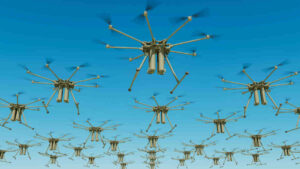Could ASX defence stocks gain from growing defence budget? Here’s what Quickstep’s CEO Mark Burgess thinks

Australian defence stocks. Picture: Getty
“In a world of perpetual tension and dread, the drums of war beat – sometimes faintly and distantly, and at other times more loudly and ever closer,” wrote Home Affairs secretary Mike Pezzullo in an Anzac Day message last year.
Those ‘drums of war’ are beating louder than ever now amid the rising geopolitical tensions.
The federal government had earlier announced plans to spend $270 billion over the next decade on upgrading our defence capabilities to “promote an open and peaceful Indo-Pacific”.
And now it’s proposing another $38 billion expansion that would see full-time Australian Defence Force (ADF) personnel grow by a third to 80,000 by 2040, a size not seen since the Vietnam War.
“More soldiers, sailors and aviators are needed to operate new military capability, including promised nuclear-powered submarines, Hunter-class frigates and advanced long-range and defensive missile systems,” said PM Morrison.
“Emerging battlefront domains such as space, information and cyber warfare are also a focus of the planned expansion of the ADF,” the PM added.
Pivot to Asia
Stockhead reached out to ASX-listed stock Quickstep Holdings (ASX:QHL), a company that offers a unique exposure to the global aerospace and defence sector.
CEO Mark Burgess is a 25-year veteran of the aerospace industry with previous experiences at British Aerospace and BAE Systems.

Burgess explained the recent defence announcement is part of a larger Western pivot to Asia, amid growing strategic risks in the region.
“Asia in many respects is going to be the centre of economic gravity this century, not withstanding what’s going on in Europe geopolitically at the moment,” he told Stockhead.
“Australia has got a very crucial role to play in the region, and what we’re seeing is a more substantive role in our security alliance with the US,” he said.
Unfortunately, Burgess said that Australia does not have the industrial base to design and build large complex programs like nuclear submarines or fighter jets – forcing us to acquire those capabilities from foreign sources like the US or other countries.
This has made the Australian defence industry somewhat peripheral within the global supply chain, and it will remain that way unless we can find a way to shore up our capabilities to get in at the very early stages of new programs.
Our defence industry faces obstacles
“The Australian government understands the challenge faced by Australian defence companies in breaking into established supply chains,” said Burgess.
“That’s why they’re taking a different approach and are saying, how do we grow an ecosystem here to supply into those programs from the very beginning? It’s a bit like what they did with F-35 program.”
The F-35 Joint Strike Fighter (JSF) aircraft program is supported by Quickstep, which supplies the vertical tail parts to BAE Systems under an agreement with BAE’s supplier, Marand Precision Engineering.
Quickstep also supplies Boeing with several composite parts for the F-15 and F-18 military aircrafts.
Apart from aerospace, Burgess sees new opportunities within the emerging field of space and guided weapons, but there are huge obstacles in the way.
“What I find most frustrating is that although the capability exists here in Australia, we have to compete with foreign suppliers who have had all the capital investment paid for by the customer,” he said.
“So we’ve got to compete with them and find a way to replicate that same capital investment, and still be competitive. It’s a really hard proposition.”
Opportunities in drones
Burgess reckons that out of the $270 billion defence budget allocated by the Australian government, around 70% of that will go to foreign suppliers, which are mainly made up of existing supply chains in Europe and North America.
So that leaves 30% of the $270 billion onshore, but then you’ve got the US defence companies locally that take the lion’s share of that (possibly another 70%).
“The remaining portion is the pot the Australian industrial base is going after,” he lamented.
“You often see multibillion dollar defence programs being announced but in the end, there are only single digit million dollar contracts being awarded to Australian companies.”
To diversify away Quicksteps’ business from the defence space, Burgess is instead eyeing the commercial and industrial markets that he believes will grow substantially over the next five years.
Commercial drone is one space he’s honing in on, a potentially huge market that experts estimated will increase to over US$50 billion by the end of the decade.
“These drones can deliver cargo at a fraction of the price. Historically they’ve been used in the medical market, delivering critical medical supplies and vaccines to remote locations such as the Pacific Islands and Africa.”
“So over the next three to five years, Quickstep’s defence business will continue to grow, but you’ll also see our commercial business grow even quicker, and this includes our aftermarket and applied composites businesses,” Burgess added.
Valuations of Aussie defence stocks
Quickstep has delivered a solid first half, with sales up by 14% to $47.3 million, and underlying pre-tax profit up 82% to $2 million.
But the QHL stock price hasn’t responded, it’s down by 25% over the last year.
Quickstep share price today:
Burgess says the share price does not fairly reflect performance, and it is way below the net present value of existing contracts.
“If you look at our performance in terms of revenue, profitability, growth, cash flow, we’re only at 3 times EBITDA,” he explained.
“Meanwhile our peers in the northern hemisphere, who have fared far worse than us during COVID, they’re trading at 15 times EBITDA,” Burgess explained.
“So my belief is that Quickstep’s valuation is completely delinked from the reality.”
He also thinks there is a general sentiment against industrial stocks in the Australian market, because the market is dominated heavily by two sectors – resources and financial services.
“Those two sectors consume all the oxygen, and it’s notoriously difficult for small caps and micro caps to have their voices heard in the Aussie market,” he said.
“But in general, I’m quite bullish on Australian stocks because supply chains now have become a much greater considerations after the pandemic. People are suddenly talking about supply chains in a way they’ve never done before.”
“And Australia is pretty darn good at supply chains, so we’ve just got to be able to tell that story more effectively and generate more interest in our business and sector in general,” said Burgess.
Other ASX-listed defence stocks
As reported by one of our experts Christian Edwards, here are some of the other defence stocks on the ASX.
| Code | Company | Price | % Year | % Month | % Today | Market Cap |
|---|---|---|---|---|---|---|
| OEC | Orbital Corp Limited | 0.32 | -55% | 14% | 19% | $24,569,107.38 |
| XTE | Xtek Limited | 0.26 | -54% | 24% | 6% | $24,651,959.78 |
| QHL | Quickstep Holdings | 0.51 | -25% | 24% | 4% | $35,097,721.96 |
| BIS | Bisalloy Steel | 1.76 | 89% | 12% | 4% | $79,492,459.00 |
| DRO | Droneshield Limited | 0.18 | 16% | 6% | 3% | $73,189,576.60 |
| KSS | Kleos | 0.565 | -8% | -16% | 3% | $97,681,866.15 |
| SOR | Strategic Elements | 0.2 | -51% | -13% | 3% | $76,221,578.75 |
| ASB | Austal Limited | 2.02 | -18% | 0% | 2% | $714,669,854.15 |
| CDA | Codan Limited | 7.19 | -50% | -20% | 1% | $1,286,084,777.85 |
| 3DP | Pointerra Limited | 0.265 | -62% | -26% | 0% | $179,618,644.06 |
| BCT | Bluechiip Limited | 0.034 | -13% | -23% | 0% | $20,351,169.06 |
| DLT | Delta Drone Intl Ltd | 0.021 | -32% | 5% | 0% | $6,297,612.30 |
| MOB | Mobilicom Ltd | 0.045 | -42% | -6% | 0% | $14,487,152.22 |
| UUV | UUV Aquabotix Ltd | 0.002 | 0% | 0% | 0% | $4,776,749.62 |
| BRN | Brainchip Ltd | 1.005 | 134% | -38% | -2% | $1,765,793,008.32 |
| AJX | Alexium Int Group | 0.055 | 8% | -14% | -4% | $36,779,625.63 |
| ELS | Elsight Ltd | 0.44 | -7% | -4% | -4% | $61,396,544.08 |
| EOS | Electro Optic Sys. | 1.855 | -65% | -16% | -4% | $292,773,604.26 |
| TTT | Titomic Limited | 0.225 | -59% | -13% | -6% | $48,248,225.52 |
Aerospace specialist Electro Optic Systems (ASX:EOS) boasts early-stage defence systems like laser physics, advanced optics, precision control systems, space domain sensors and communications technologies, and remote operated combat vehicles.
Another aerospace company, Orbital Corp (ASX:OEC), makes integrated engine systems for tactical unmanned aerial vehicles too, like its ScanEagle 3 model.
The company also manufactures aeroengines for Boeing from its Perth-based and US facilities, and is developing a hybrid propulsion system for a vertical take-off and landing UAV with defence technology company Northrop Grumman.
Space-powered radio frequency reconnaissance company Kleos Space (ASX:KSS) secured a $12 million cap-raise to fund the launch of future satellite clusters, and to scale up Kleos’ data-as-a-service offering.
Elsight (ASX:ELS) has developed communication technology for real-time data, video and audio transmission over cellular networks and sees significant opportunities around drones.
Xtek (ASX:XTE) managing director Philippe Odouard said he’s seen first-hand the massive change in how the Australian military is adopting drone tech.
The company signed its first sales contact with the Australian Defence Force back in 2017, and since then has sold hundreds of drone systems.
Speaking to Stockhead earlier, Droneshield (ASX:DRO) chief executive officer Oleg Vornik says he’s seen both Russian and Ukrainian forces use small drones for battlefield surveillance.
“More generally, cyber warfare and other asymmetric and grey-zone warfare including the deployment of military without ID or unit badges on them have been increasingly used by the Russians,” he said.
The views, information, or opinions expressed in the interview in this article are solely those of the interviewee and do not represent the views of Stockhead.
Stockhead has not provided, endorsed or otherwise assumed responsibility for any financial product advice contained in this article.
Related Topics
UNLOCK INSIGHTS
Discover the untold stories of emerging ASX stocks.
Daily news and expert analysis, it's free to subscribe.
By proceeding, you confirm you understand that we handle personal information in accordance with our Privacy Policy.








